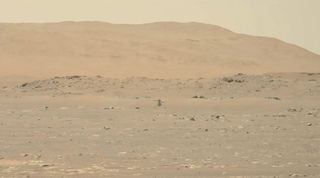NASA's Mars helicopter Ingenuity just made aviation history, and its robotic buddy caught the whole thing on video.
Early this morning (April 19), Ingenuity aced the first-ever powered flight on a world beyond Earth. The 4-lb. (1.8 kilograms) chopper rose 10 feet (3 meters) above the floor of Jezero Crater, stayed aloft in Mars' thin air for 39 seconds and came down for a pinpoint landing at its takeoff spot.
And we have high-definition documentation of this otherworldly Wright Brothers moment thanks to NASA's Perseverance rover, which recorded the flight from 230 feet (70 m) away using its powerful Mastcam-Z camera system.
"Absolutely beautiful flight!" Ingenuity project manager MiMi Aung said today during a press conference that provided details about the landmark flight and unveiled Perseverance's video.
"I don't think I can ever stop watching it over and over again," added Aung, who's based at NASA's Jet Propulsion Laboratory (JPL) in Southern California.
Video: Watch Ingenuity's first flight on Mars
A helicopter on Mars

Ingenuity landed with Perseverance inside Jezero on Feb. 18 and deployed from the rover's belly early this month. The solar-powered rotorcraft carries two cameras but no scientific instruments. It's a technology demonstration designed to show that powered flight is possible on Mars, which has an atmosphere just 1% as thick as that of Earth at sea level.
Get the Space.com Newsletter
Breaking space news, the latest updates on rocket launches, skywatching events and more!
Perseverance's main jobs are to hunt for signs of ancient life on Mars and collect and cache samples for future return to Earth, but the rover won't start that work in earnest until Ingenuity's month-long flight campaign comes to an end. Perseverance is documenting that campaign and supporting it in crucial ways. For example, all communications to and from the solar-powered chopper are routed through the rover.
Related: Arnold Schwarzenegger tells NASA to 'Get to the choppa!'
Aung and her colleagues plan to conduct four more flights in the two weeks they have left in the campaign, with number two tentatively scheduled for Thursday (April 19). (The clock started ticking when Ingenuity deployed from Perseverance, and the helicopter's first flight was delayed by about a week as the team worked to resolve a software issue.)
Those flights will get increasingly more complex and ambitious, with the team flying Ingenuity higher, farther and faster as time goes on.
"This is a pathfinder," Aung said. "We really want to know what the limits are, so we will be pushing the limits very deliberately."
She said she'd like Ingenuity to travel about 2,000 feet (600 m) downrange on its fifth and final flight, provided the helicopter performs well on sorties two through four. It's unclear where Ingenuity will go on its last liftoff, but it's possible that the long flight will aid the planning of Perseverance's roving routes; Aung said she's agnostic about flight direction and will ask the rover team if they have any preferences.
Related: How NASA's Mars helicopter Ingenuity can fly on the Red Planet
The future of off-planet flying

Such scouting work, if it does indeed happen, would serve as a fitting bridge to the future that Ingenuity is helping to unlock — a future in which aerial exploration of Mars is common, and helicopters do a variety of important tasks on the Red Planet.
"What the Ingenuity team has done is given us the third dimension," JPL director Mike Watkins said during today's press conference.
"They've freed us from the surface now forever in planetary exploration, so that we can now make a combination, of course, of driving on the surface and sampling the surface and doing reconnaissance and even scientific experimentation on inaccessible places for a rover," he added. "And I think this is exactly the way we build the future."
Mike Wall is the author of "Out There" (Grand Central Publishing, 2018; illustrated by Karl Tate), a book about the search for alien life. Follow him on Twitter @michaeldwall. Follow us on Twitter @Spacedotcom or Facebook.
Join our Space Forums to keep talking space on the latest missions, night sky and more! And if you have a news tip, correction or comment, let us know at: community@space.com.

Michael Wall is a Senior Space Writer with Space.com and joined the team in 2010. He primarily covers exoplanets, spaceflight and military space, but has been known to dabble in the space art beat. His book about the search for alien life, "Out There," was published on Nov. 13, 2018. Before becoming a science writer, Michael worked as a herpetologist and wildlife biologist. He has a Ph.D. in evolutionary biology from the University of Sydney, Australia, a bachelor's degree from the University of Arizona, and a graduate certificate in science writing from the University of California, Santa Cruz. To find out what his latest project is, you can follow Michael on Twitter.
